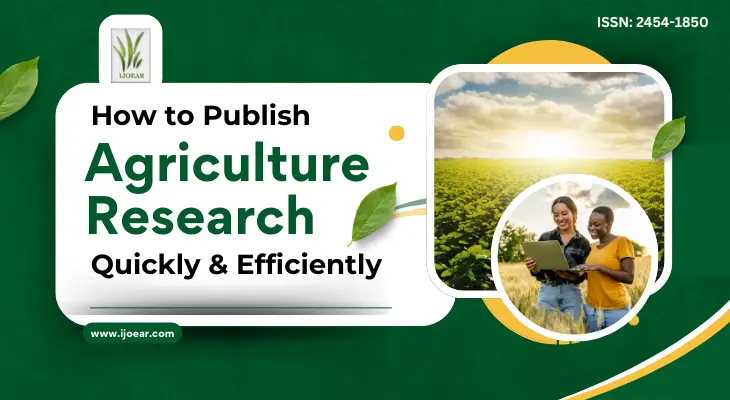
Publishing agricultural research quickly is essential for researchers looking to share their findings, contribute to scientific advancements, and gain professional recognition. However, the process can be time-consuming due to peer review, editorial evaluations, and formatting requirements. This blog provides strategies to streamline the publication process and highlights journals that offer fast-track publication options.
To publish research efficiently, it is crucial to understand the key steps involved in the publication process:
Some journals provide a fast-track review process that expedites publication. Look for journals with a clear timeline for peer review and online-first publication.
Open-access journals provide rapid online publication and wider visibility. Many reputable open-access agriculture journals offer accelerated peer review options.
Timely revisions and resubmissions speed up the acceptance process. Address reviewer feedback comprehensively.
The International Journal of Environmental and Agriculture Research (IJOEAR) follows a structured and transparent publication process to maintain high research standards and provide global visibility to authors.
Authors submit their research papers through the online submission system or via email. The submission should adhere to the journal’s guidelines, including formatting, reference style, and plagiarism policy.
Once submitted, the editorial team conducts an initial screening to verify the manuscript’s compliance with IJOEAR’s scope, originality, and ethical standards. A plagiarism check is performed to ensure the research is original.
The manuscript undergoes a double-blind peer review process, where expert reviewers evaluate the research for:
Reviewers may suggest revisions, which authors must address before the next stage.
The editorial team, along with the authors, refines the manuscript by correcting errors, improving clarity, and ensuring quality. Authors receive the final version for confirmation before publication.
Once the author approves the final version, the manuscript undergoes final formatting, including DOI assignment, metadata inclusion, and indexing preparation.
The approved manuscript is published in the current issue of IJOEAR and made available open-access to researchers worldwide. It is indexed in various databases, increasing visibility and citations.
IJOEAR promotes published papers through:
Publishing agricultural research quickly requires strategic planning, journal selection, and efficient manuscript preparation. Choosing the right journal, adhering to submission guidelines, and responding promptly to reviewers can significantly reduce the publication timeline. For a fast and reliable publishing experience, consider IJOEAR, which provides rapid peer review and open-access publication.
1. What are the key steps to publish agriculture research efficiently?
Start by selecting a suitable journal, preparing a well-structured manuscript, ensuring it meets the journal's guidelines, using proper references, and submitting through the correct platform. Clear, concise writing and following submission protocols speed up the process.
2. How do I choose the right journal for my agricultural research?
Look for journals that align with your topic, have a good reputation, offer fast review times, and are indexed in databases like Scopus, Web of Science, or DOAJ. Check if they accept open access submissions for quicker visibility.
3. Does formatting affect the speed of publication?
Yes. Submitting your paper in the journal’s required format minimizes back-and-forth communication with editors and can significantly reduce publication delays.
4. Can preprint platforms help in quick visibility?
Absolutely. Preprint servers like AgriRxiv allow researchers to share their findings quickly while awaiting peer review, increasing early visibility and citations.
5. How important is peer review in the publishing process?
Peer review ensures the credibility and quality of your research. Choosing journals with single- or rapid-peer review systems can accelerate the publishing timeline without compromising quality.
6. What are some tips for writing a research paper quickly?
Create a detailed outline, use reference management tools, write daily in short focused sessions, and edit in stages. Collaborating with co-authors can also divide the workload efficiently.
7. Are there journals that offer fast-track or express publication?
Yes, many agriculture journals now offer fast-track options for an additional fee or based on research priority. Always verify the journal’s authenticity before choosing this option.
8. How can I avoid rejection and resubmission delays?
Ensure your research is original, data is sound, references are current, and language is clear. Submitting to the wrong journal or ignoring guidelines are common causes of rejection.
 NAAS Rating: 4.23
NAAS Rating: 4.23  October 2025 Issue
October 2025 Issue  Impact Factor: 6.69
Impact Factor: 6.69  Submit Article
Submit Article 
|
Citation Indices
|
All
|
Since 2020
|
|
Citation
|
6164
|
5117
|
|
h-index
|
31
|
29
|
|
i10-index
|
201
|
165
|
|
Acceptance Rate (By Year)
|
|
|
Year
|
Percentage
|
|
2024
|
11.09%
|
|
2023
|
15.23%
|
|
2022
|
12.81%
|
|
2021
|
10.45%
|
|
2020
|
9.6%
|
|
2019
|
14.3%
|
|
2018
|
17.65%
|
|
2017
|
16.9%
|
|
2016
|
22.9%
|
|
2015
|
26.1%
|